Hybrid Sparse Array Design Based on Pseudo-Random Algorithm and Convex Optimization with Wide Beam Steering
Abstract
1. Introduction
2. Model of Optimization
3. Proposed Algorithm
3.1. Pseudo-Random Algorithm
3.2. Convex Algorithm
3.3. Procedure of Hybrid Algorithm
4. Simulation Results
4.1. Radiation Pattern Analysis
4.2. Beam Steering
5. Conclusions
Author Contributions
Funding
Institutional Review Board Statement
Informed Consent Statement
Data Availability Statement
Conflicts of Interest
References
- Ahmed, S.S.; Schiessl, A.; Schmidt, L.P. A Novel Fully Electronic Active Real-Time Imager Based on a Planar Multistatic Sparse Array. IEEE Trans. Microw. Theory Tech. 2011, 59, 3567–3576. [Google Scholar] [CrossRef]
- Abbasi, H. Sparse: A More Modern Sparse Array Library; SciPy: Austin, TX, USA, 2018; pp. 65–68. [Google Scholar] [CrossRef]
- Zheng, Z.; Wang, W.Q.; Kong, Y.; Zhang, Y.D. MISC Array: A New Sparse Array Design Achieving Increased Degrees of Freedom and Reduced Mutual Coupling Effect. IEEE Trans. Signal Process. 2019, 67, 1728–1741. [Google Scholar] [CrossRef]
- Alnahwi, F.M.; Al-Yasir, Y.I.A.; Sattar, D.; Ali, R.S.; See, C.H.; Abd-Alhameed, R.A. A New Optimization Algorithm Based on the Fungi Kingdom Expansion Behavior for Antenna Applications. Electronics 2021, 10, 2057. [Google Scholar] [CrossRef]
- Niccolai, A.; Zich, R.; Beccaria, M.; Pirinoli, P. SNO Based Optimization for Shaped Beam Reflectarray Antennas. In Proceedings of the 2019 13th European Conference on Antennas and Propagation (EuCAP), Krakow, Poland, 31 March–5 April 2019; pp. 1–4. [Google Scholar]
- Mo, H.; Tong, Y.; Wang, Y.; Wang, K.; Luo, D.; Li, W. Sparse Non-Uniform Linear Array-Based Propagator Method for Direction of Arrival Estimation. Electronics 2023, 12, 3755. [Google Scholar] [CrossRef]
- Alidoustaghdam, H.; Kokkeler, A.; Miao, Y. Sparse Tiled Planar Array: The Shared Multibeam Aperture for Millimeter-Wave Joint Communication and Sensing. Electronics 2023, 12, 3115. [Google Scholar] [CrossRef]
- Shi, W.; Li, Y. Novel Sparse Array Design Based on the Maximum Inter-Element Spacing Criterion. IEEE Signal Process. Lett. 2022, 29, 1754–1758. [Google Scholar] [CrossRef]
- Ahmed, A.; Zhang, Y.D. Generalized Non-Redundant Sparse Array Designs. IEEE Trans. Signal Process. 2021, 69, 4580–4594. [Google Scholar] [CrossRef]
- Hamza, S.A.; Amin, M.G. Hybrid Sparse Array Beamforming Design for General Rank Signal Models. IEEE Trans. Signal Process. 2019, 67, 6215–6226. [Google Scholar] [CrossRef]
- Vigano, M.; Toso, G.; Angeletti, P.; Lager, I.; Yarovoy, A.; Caratelli, D. Sparse antenna array for earth-coverage satellite applications. In Proceedings of the 4th European Conference on Antennas and Propagation—EuCAP, Barcelona, Spain, 12–16 April 2010; pp. 1–4. [Google Scholar]
- Chiao, R.; Thomas, L.; Silverstein, S. Sparse array imaging with spatially-encoded transmits. In Proceedings of the 1997 IEEE Ultrasonics Symposium Proceedings, An International Symposium (Cat. No.97CH36118), Toronto, ON, Canada, 5–8 October 1997; Volume 2, pp. 1679–1682. [Google Scholar] [CrossRef]
- Bucci, O.M.; Isernia, T.; Perna, S.; Pinchera, D. Isophoric Sparse Arrays Ensuring Global Coverage in Satellite Communications. IEEE Trans. Antennas Propag. 2014, 62, 1607–1618. [Google Scholar] [CrossRef]
- Ephrat, P.; Keenliside, L.; Seabrook, A.; Prato, F.S.; Carson, J.J.L. Three-dimensional photoacoustic imaging by sparse-array detection and iterative image reconstruction. J. Biomed. Opt. 2008, 13, 054052. [Google Scholar] [CrossRef]
- Wang, X.; Hassanien, A.; Amin, M.G. Dual-Function MIMO Radar Communications System Design via Sparse Array Optimization. IEEE Trans. Aerosp. Electron. Syst. 2019, 55, 1213–1226. [Google Scholar] [CrossRef]
- Athley, F.; Engdahl, C.; Sunnergren, P. On radar detection and direction finding using sparse arrays. IEEE Trans. Aerosp. Electron. Syst. 2007, 43, 1319–1333. [Google Scholar] [CrossRef]
- Beni, A.; Miccinesi, L.; Pieraccini, M. Comparison between Compressive Sensing and Non-Uniform Array for a MIMO GBSAR with Elevation Resolution: Simulations and Experimental Tests. Electronics 2023, 12, 1100. [Google Scholar] [CrossRef]
- Shao, W.; Hu, J.; Ji, Y.; Zhang, W.; Fang, G. W-Band FMCW MIMO System for 3-D Imaging Based on Sparse Array. Electronics 2024, 13, 369. [Google Scholar] [CrossRef]
- Liang, C.; Wang, Y.; Yang, Z.; Hu, X.; Pei, Q.; Gu, W.; Zhang, L. Cooperative Automotive Radars with Multi-Aperture Multiplexing MIMO Sparse Array Design. Electronics 2022, 11, 1198. [Google Scholar] [CrossRef]
- Wei, S.J.; Zhang, X.L.; Shi, J.; Liao, K.F. Sparse array microwave 3-D imaging: Compressed sensing recovery and experimental study. Prog. Electromagn. Res. 2013, 135, 161–181. [Google Scholar] [CrossRef]
- Nipanikar, S.; Hima Deepthi, V.; Kulkarni, N. A sparse representation based image steganography using Particle Swarm Optimization and wavelet transform. Alex. Eng. J. 2018, 57, 2343–2356. [Google Scholar] [CrossRef]
- Zhang, H.; Bai, B.; Zheng, J.; Zhou, Y. Optimal Design of Sparse Array for Ultrasonic Total Focusing Method by Binary Particle Swarm Optimization. IEEE Access 2020, 8, 111945–111953. [Google Scholar] [CrossRef]
- Chen, K.; Yun, X.; He, Z.; Han, C. Synthesis of Sparse Planar Arrays Using Modified Real Genetic Algorithm. IEEE Trans. Antennas Propag. 2007, 55, 1067–1073. [Google Scholar] [CrossRef]
- Ares-Pena, F.; Rodriguez-Gonzalez, J.; Villanueva-Lopez, E.; Rengarajan, S. Genetic algorithms in the design and optimization of antenna array patterns. IEEE Trans. Antennas Propag. 1999, 47, 506–510. [Google Scholar] [CrossRef]
- Enache, F.; Deparateanu, D.; Enache, A.; Popescu, F. Sparse array antenna design based on dolph-chebyshev and genetic algorithms. In Proceedings of the 2016 8th International Conference on Electronics, Computers and Artificial Intelligence (ECAI), Ploiesti, Romania, 30 June–2 July 2016; pp. 1–4. [Google Scholar] [CrossRef]
- Fuchs, B. Synthesis of Sparse Arrays with Focused or Shaped Beampattern via Sequential Convex Optimizations. IEEE Trans. Antennas Propag. 2012, 60, 3499–3503. [Google Scholar] [CrossRef]
- Hong, T.; Shi, X.P.; Liang, X.S. Synthesis of Sparse Linear Array for Directional Modulation via Convex Optimization. IEEE Trans. Antennas Propag. 2018, 66, 3959–3972. [Google Scholar] [CrossRef]
- Sayyah, K.; Efimov, O.; Patterson, P.; Schaffner, J.; White, C.; Seurin, J.F.; Xu, G.; Miglo, A. Two-dimensional pseudo-random optical phased array based on tandem optical injection locking of vertical cavity surface emitting lasers. Opt. Express 2015, 23, 19405. [Google Scholar] [CrossRef] [PubMed]
- Boyd, S.; Vandenberghe, L. Convex Optimization; Cambridge University Press: Cambridge, UK, 2004. [Google Scholar]
- Tütüncü, R.H.; Toh, K.C.; Todd, M.J. Solving semidefinite-quadratic-linear programs using SDPT3. Math. Program. 2003, 95, 189–217. [Google Scholar] [CrossRef]
- Borchers, B.; Young, J.G. Implementation of a primal–dual method for SDP on a shared memory parallel architecture. Comput. Optim. Appl. 2007, 37, 355–369. [Google Scholar] [CrossRef][Green Version]
- Aldaya, I.; Dias, B.; Santos, M.P.; De Oliveira, J.A.; Abbade, M.L.F.; Penchel, R.A. Optimization of mean inter-element distance in aperiodic sparse linear phased array antennas. In Proceedings of the 2022 IEEE International Symposium on Antennas and Propagation and USNC-URSI Radio Science Meeting (AP-S/URSI), Denver, CO, USA, 10–15 July 2022; pp. 1276–1277. [Google Scholar] [CrossRef]

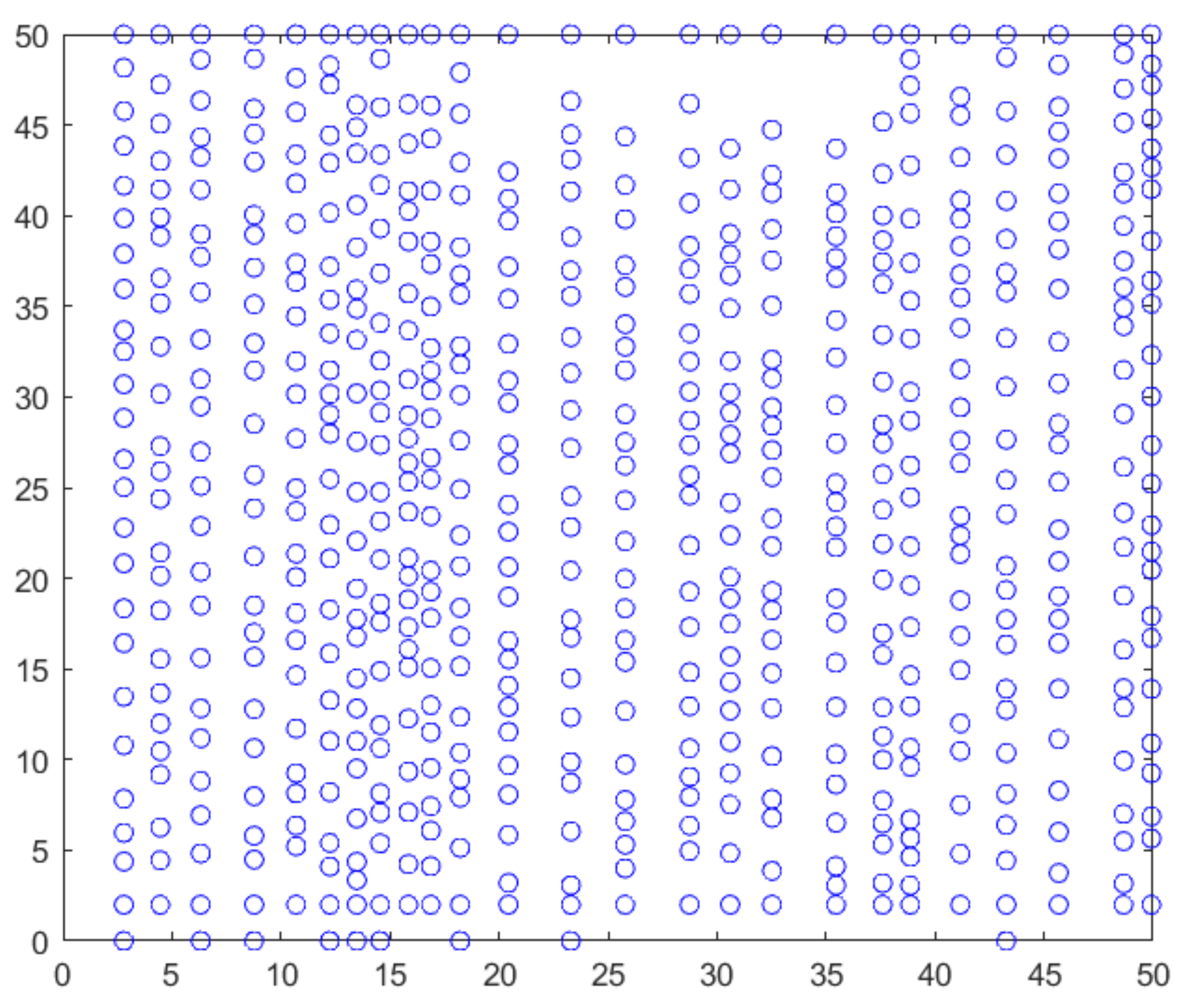
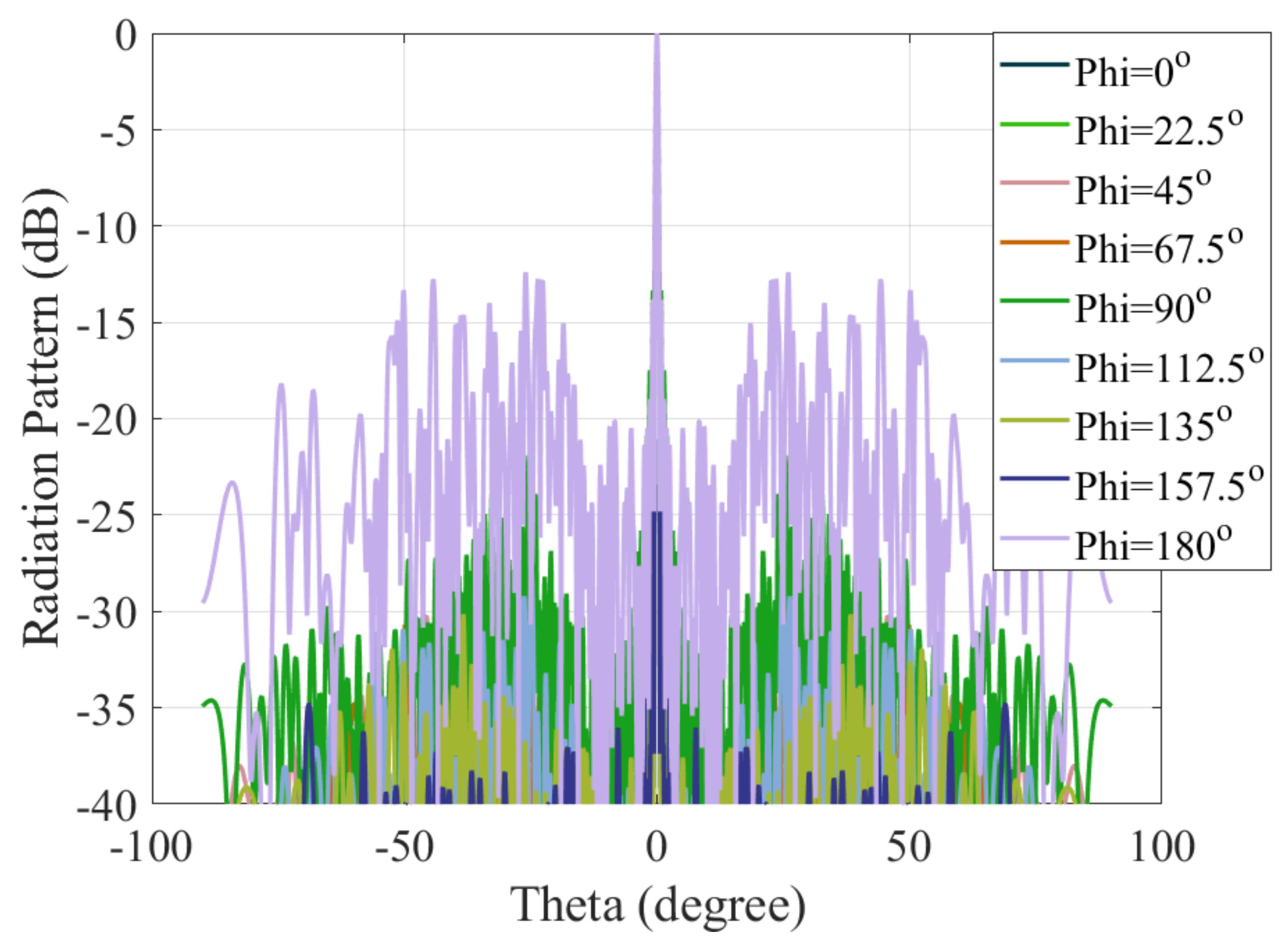
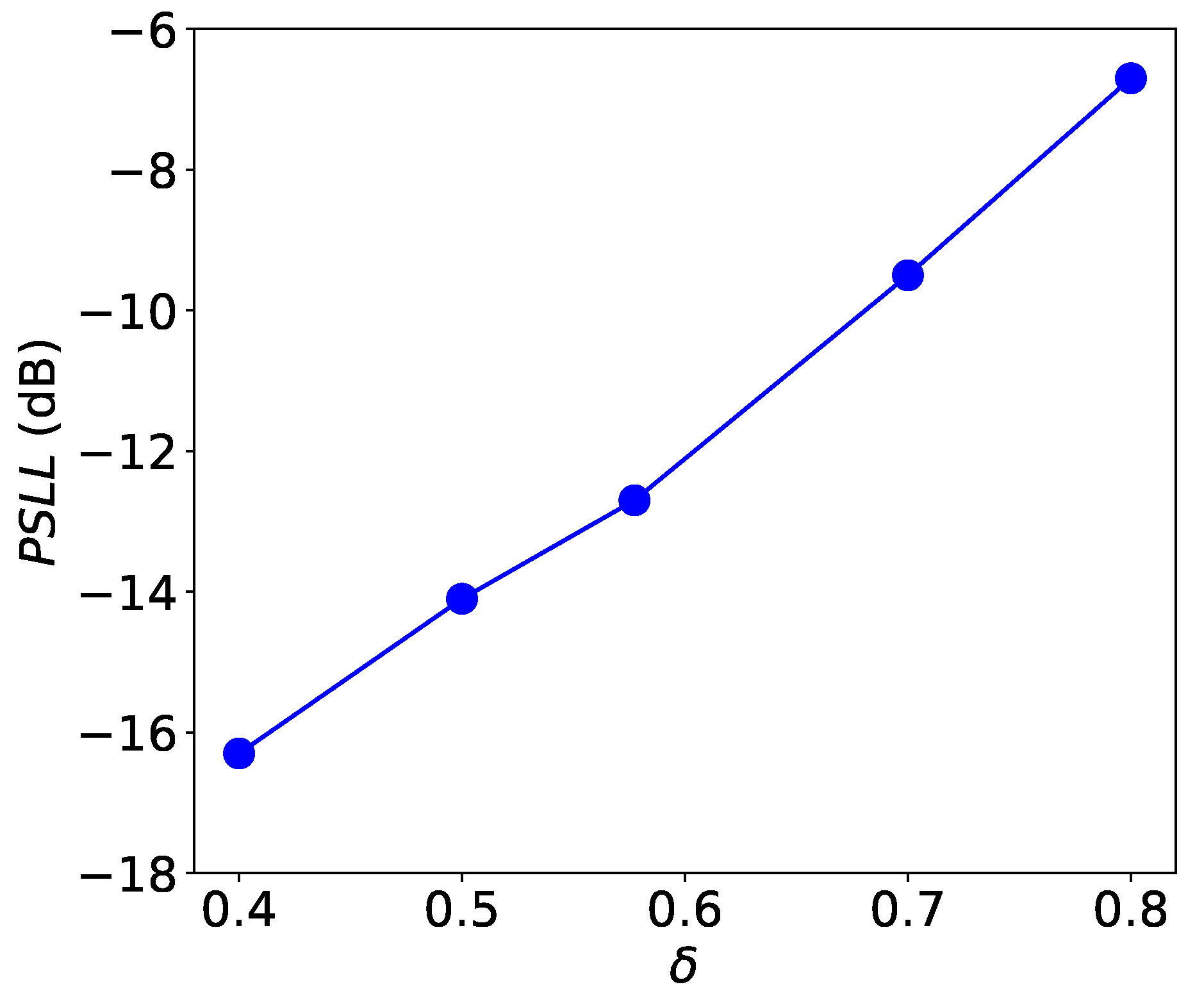
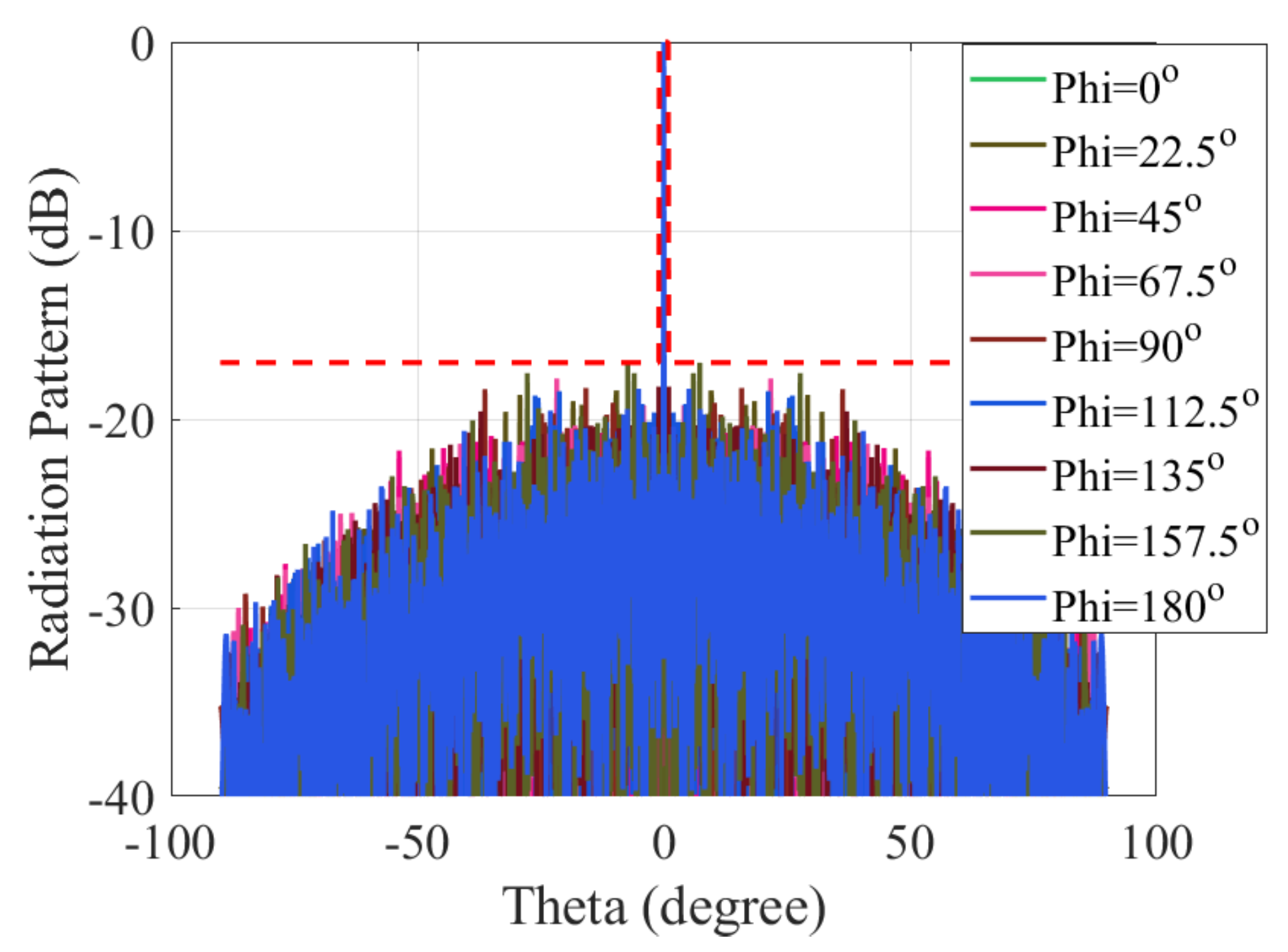
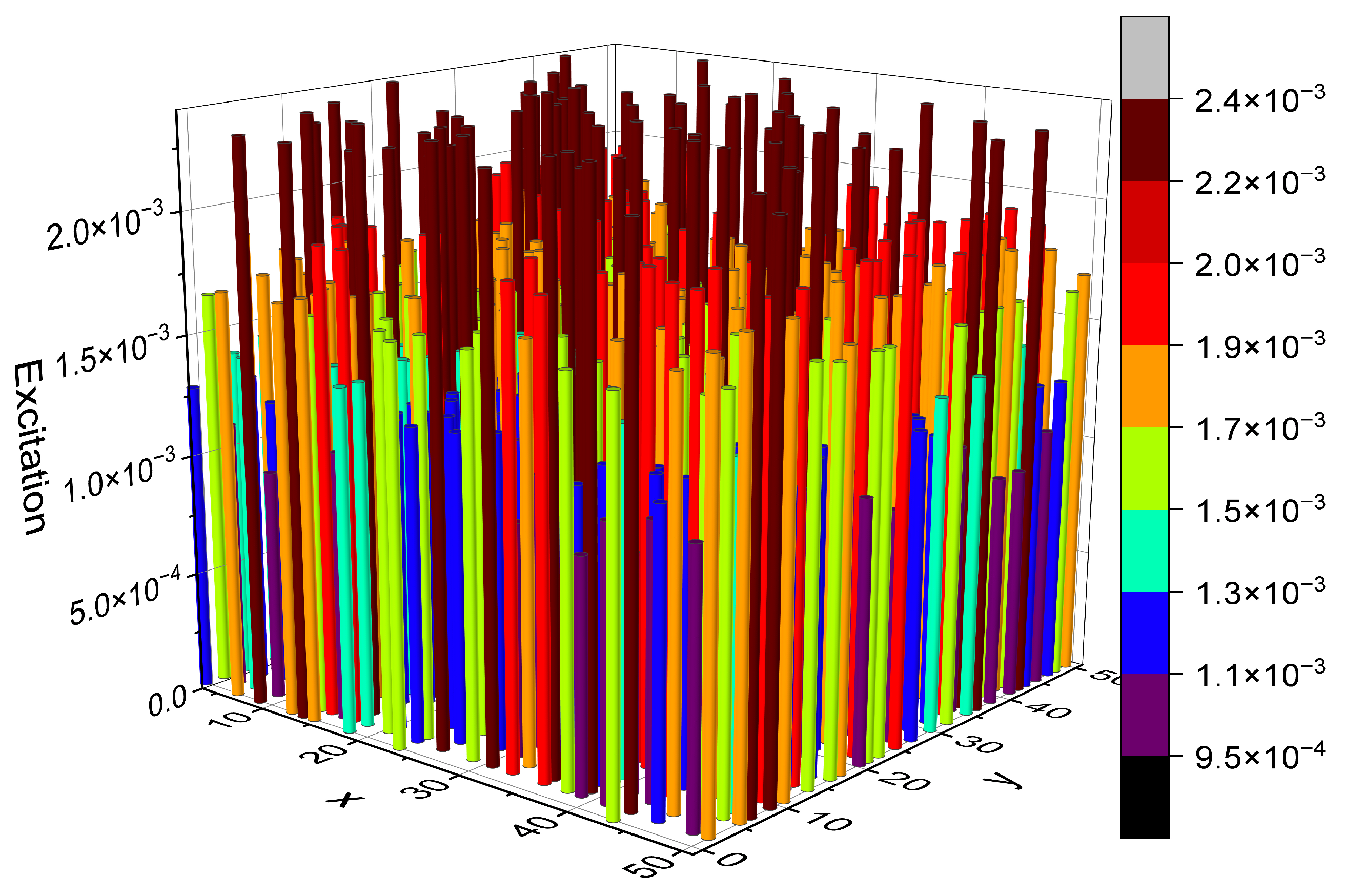

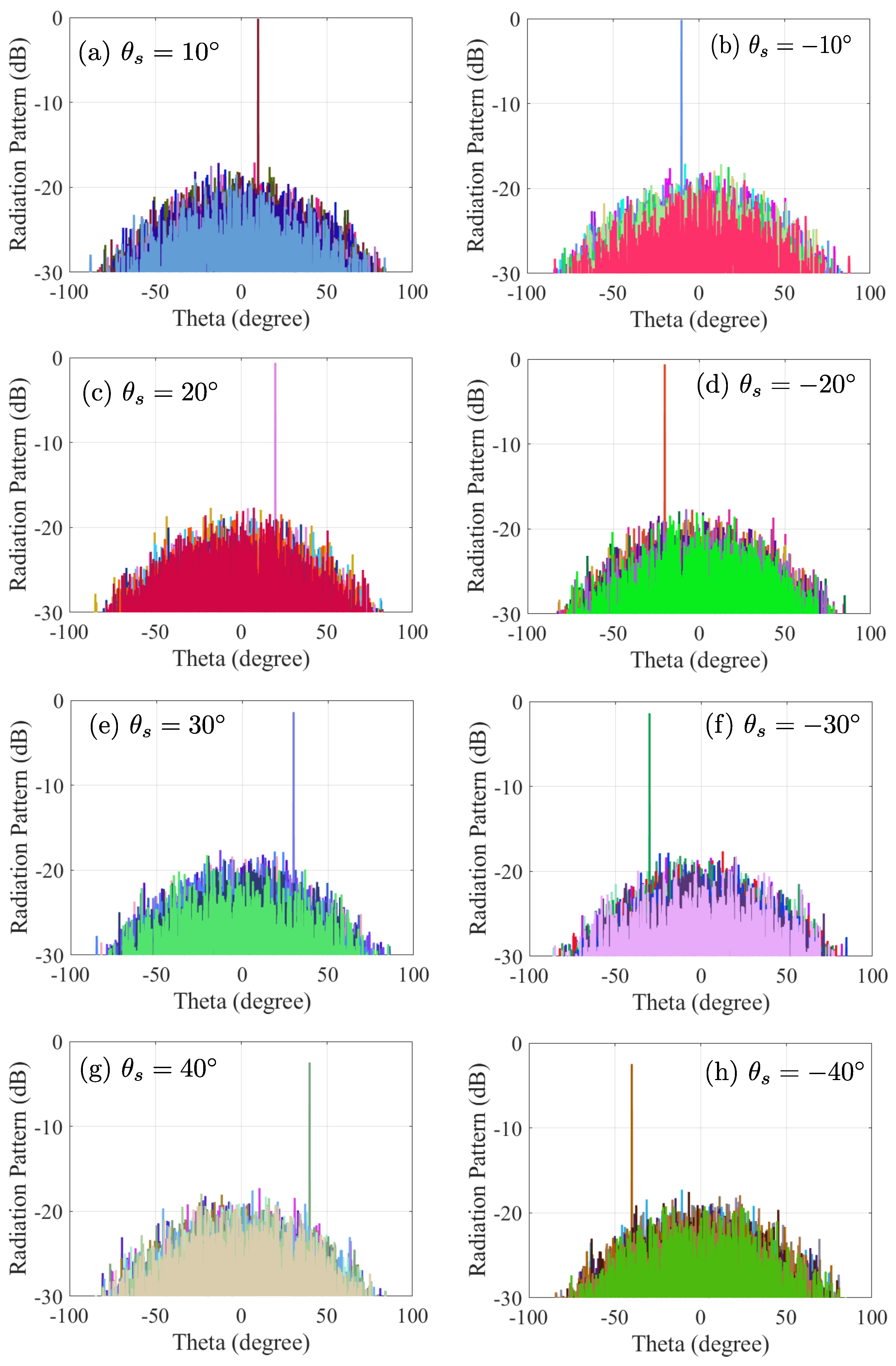
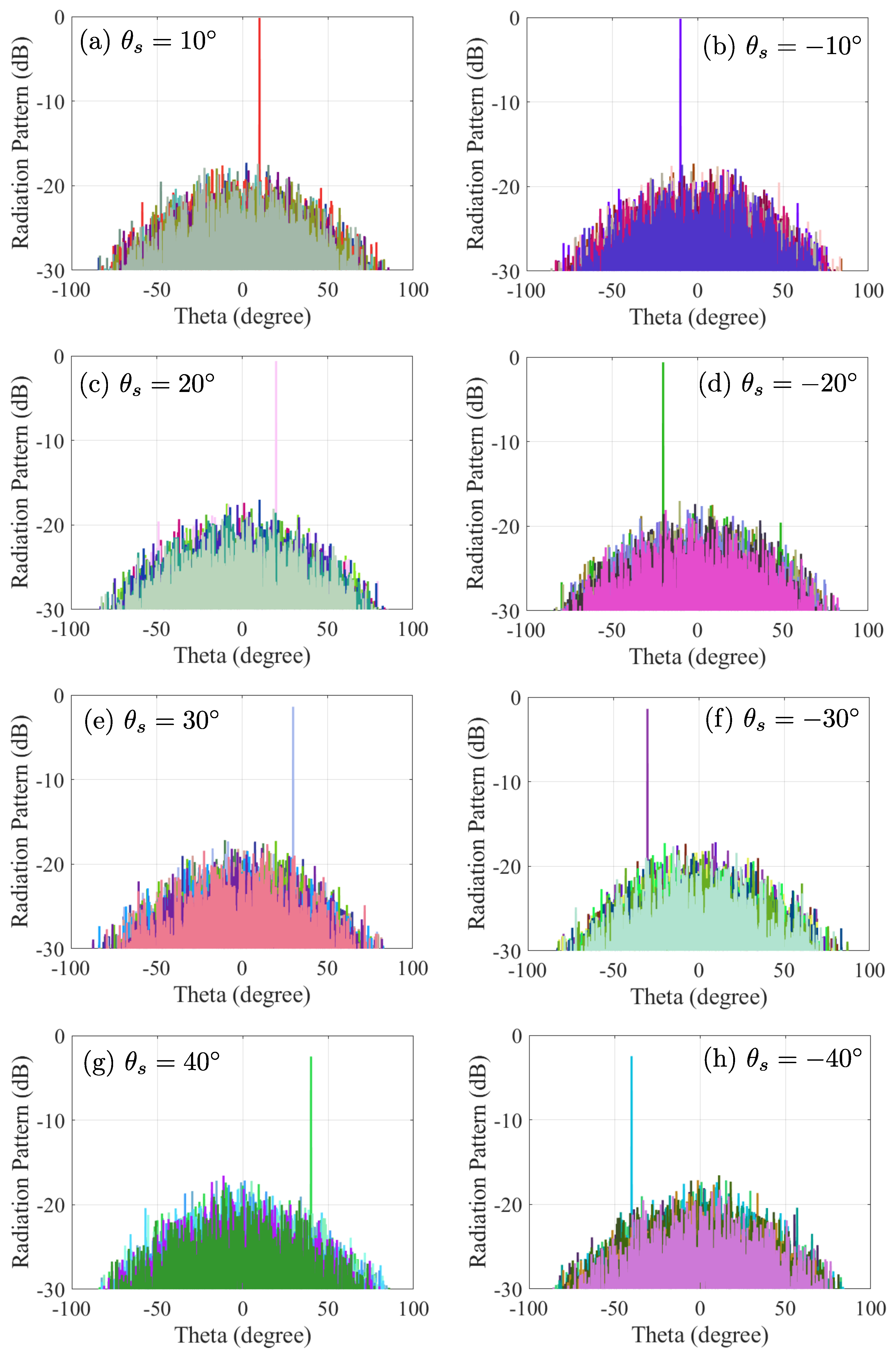
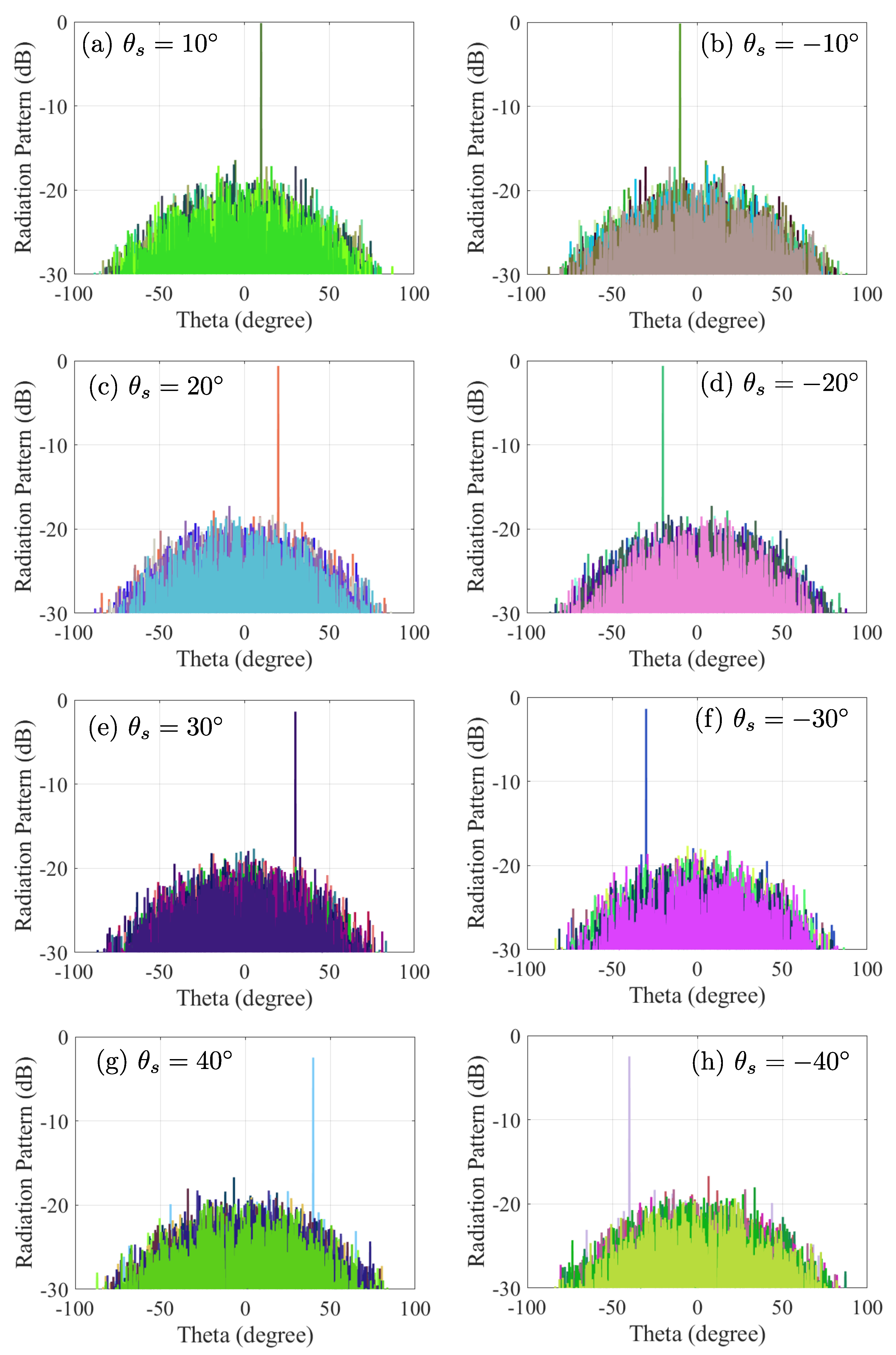
Disclaimer/Publisher’s Note: The statements, opinions and data contained in all publications are solely those of the individual author(s) and contributor(s) and not of MDPI and/or the editor(s). MDPI and/or the editor(s) disclaim responsibility for any injury to people or property resulting from any ideas, methods, instructions or products referred to in the content. |
© 2024 by the authors. Licensee MDPI, Basel, Switzerland. This article is an open access article distributed under the terms and conditions of the Creative Commons Attribution (CC BY) license (https://creativecommons.org/licenses/by/4.0/).
Share and Cite
Gao, P.; Chen, Z. Hybrid Sparse Array Design Based on Pseudo-Random Algorithm and Convex Optimization with Wide Beam Steering. Electronics 2024, 13, 4422. https://doi.org/10.3390/electronics13224422
Gao P, Chen Z. Hybrid Sparse Array Design Based on Pseudo-Random Algorithm and Convex Optimization with Wide Beam Steering. Electronics. 2024; 13(22):4422. https://doi.org/10.3390/electronics13224422
Chicago/Turabian StyleGao, Pan, and Zhongquan Chen. 2024. "Hybrid Sparse Array Design Based on Pseudo-Random Algorithm and Convex Optimization with Wide Beam Steering" Electronics 13, no. 22: 4422. https://doi.org/10.3390/electronics13224422
APA StyleGao, P., & Chen, Z. (2024). Hybrid Sparse Array Design Based on Pseudo-Random Algorithm and Convex Optimization with Wide Beam Steering. Electronics, 13(22), 4422. https://doi.org/10.3390/electronics13224422



